Bibliography Background About KRIS
Riparian Zones, Large Wood and Suitability of Streams for Atlantic Salmon
Habitat: Canopy and Stream Width in Maine Salmon Rivers 1984-2000
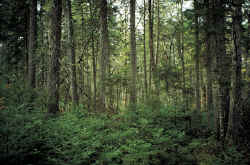 The forests of Maine have been widely disturbed over the last 300 years by colonization, agriculture and commercial timber harvest (Lorimer, 1977). Less than 4% of Maine's old growth forests remain undisturbed, and most of that habitat is in the northern portion of the state (Irland, 1998). With so little undisturbed forest, it is difficult to study the relationship between forest conditions and Atlantic salmon stream habitats by comparing those flowing from disturbed and undisturbed forests. However, there are a number of recent studies on riparian function and riparian protection in Maine, other New England states, Europe and the Pacific Northwest, which can be used to analyze relationships and guide restoration (Laser, 2005).
The forests of Maine have been widely disturbed over the last 300 years by colonization, agriculture and commercial timber harvest (Lorimer, 1977). Less than 4% of Maine's old growth forests remain undisturbed, and most of that habitat is in the northern portion of the state (Irland, 1998). With so little undisturbed forest, it is difficult to study the relationship between forest conditions and Atlantic salmon stream habitats by comparing those flowing from disturbed and undisturbed forests. However, there are a number of recent studies on riparian function and riparian protection in Maine, other New England states, Europe and the Pacific Northwest, which can be used to analyze relationships and guide restoration (Laser, 2005).
In the Pacific Northwest, one of the most important functions of riparian zones is their contribution of large downed logs, or large woody debris, that provide habitat forming elements in salmon streams (Bilby and Ward, 1989; Spence et al., 1996). Aquatic habitat in Oregon coastal streams in undisturbed and lightly disturbed watersheds remain sufficiently complex to support several Pacific salmon species, while watersheds with widespread logging (>25%) have fewer pieces of large wood, simplified channels and support only one salmon species (Reeves et al., 1993). Dahlström and Nilsson (2004) found much greater aquatic habitat complexity in Swedish streams flowing through old growth forests than in ones with previously managed riparian areas.
The Maine Atlantic Salmon Commission (1997) acknowledges that large wood in streams can "help create protective holding pools for Atlantic salmon, particularly juvenile salmonids" but also expressed concern about the need to clear streams of log jams to allow salmon passage. The National Marine Fisheries Service and U.S. Fish and Wildlife Service's (2004) Draft Recovery Plan for the Gulf of Maine Distinct Population Segment of Atlantic Salmon recognizes the need to protect and restore riparian areas, and Kleinschmidt (1999) has helped define buffer widths. Groups aiding in Atlantic salmon recovery have begun assessing riparian conditions and have started public education and outreach as well as restoration efforts (SRWC, 2000).
History of Maine Forests and Potential Large Wood Recruitment
In order to understand how much and what type of large wood might have recruited to Maine's Atlantic salmon rivers, one must understand the historical distribution patterns of forests and riparian zones. The State of Maine's Forests (Sader et al., 2004) describes the evolution of forested landscapes:
"Glaciers retreated from what is now eastern Canada and northern New England approximately 14,000 to 9,000 years ago. As the glaciers retreated, the landscape became more vegetated, changing from a continuum of tundra to woodland to forests. Vegetative assemblages continually changed, with past assemblages not only different from each other, but also dissimilar from modern forest types. Prior to European settlement, the disturbance regime was infrequent and local, and thus the forests were largely in an uneven-aged climax state. In north-central Maine, an estimated 59% of the forest was in mature climax (i.e., stands with trees 150 years old); 27% of the forest was in an all-aged climax with trees 300 years old and older."
USGS (2004) indicate major shifts in tree species over time, with spruce-fir forests becoming dominant about 1,000 years ago, when they displaced eastern hemlock and American Beech. Forests dominated by red spruce and balsam fir still cover 4.1 million hectares of New England, but their age structure is very different than in the period prior to disturbance (USGS, 2004):
"The second- and third-growth forests under management have much less age diversity than the pre-settlement forests. Although red spruce remains abundant, balsam fir has no doubt expanded greatly. Selective logging of conifers has also reduced tree species richness of formerly mixed stands that are now composed of pure northern hardwoods."
Irland (1998) recounts major decreases in Maine's forests to 70% of the landscape by 1880 as a result of agriculture, while the NRC (2003) estimates that forested areas had actually decreased to at greater extent, and covered only 53% of the land. Plantinga et al. (1999) track the recent history of forest cover changes and use econometric modeling tools to project future trends in Maine forest land. They found that since 1950 the area of forest in Maine has increased by almost 400,000 acres as rural agriculture declined and by 1995 more than 90 percent of Maine was covered in forests. Ownership patterns indicate that non-industrial private timberland declined by 800,000 acres since 1950, but industrial timberland ownership rose by 681,000 acres (Plantinga et al., 1999). Projections indicate that "private timberland area will decline by almost 3 percent by 2050" and urbanization will increase (see Urbanization Background page).
Possible Significance of Riparian Changes Over Time for Atlantic Salmon and Water Quality
USGS (2004) describe spruce flat ecotypes that existed before disturbance, where spruce-fir forests predominated on poorly drained, acidic soils of glacial origin. They also define pre-disturbance spruce swamps with nearly pure stands of black spruce with tamarack and Atlantic white cedar growing in organic, poorly drained soils (USGS, 2004). These two ecotypes likely extended into the lowlands of the Sheepscot River because of its history of glaciation, mild topography and marshy areas surrounding its tributaries. Although these trees were probably a maximum of 100 feet high, some species may have lived up to 300 years and achieved large diameters. Riparian conifers may last decades when they fall into the stream and increase pool frequency, while hardwoods generally last no more than 5-10 years (Cedarholm et al., 1997). It is likely that old growth riparian conifers in Maine forests before European colonization would have contributed large woody debris to Atlantic salmon streams and helped form habitat, however, no data from Gulf of Maine control streams is available to test this hypothesis (Laser, 2005).
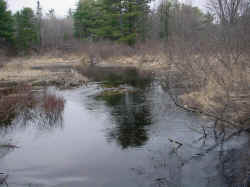 This photo shows a reach of the Dyer River, a tributary of the lower Sheepscot River, that has very marshy conditions. The coniferous trees in the wet riparian areas match the description of spruce swamps per USGS (2004). Such very wet areas may have defied efforts to farm because of irremediable drainage problems. Note the beaver dam at center-left in the photo.
This photo shows a reach of the Dyer River, a tributary of the lower Sheepscot River, that has very marshy conditions. The coniferous trees in the wet riparian areas match the description of spruce swamps per USGS (2004). Such very wet areas may have defied efforts to farm because of irremediable drainage problems. Note the beaver dam at center-left in the photo.
Grow (1975) described early settlement in the Sheepscot River basin, known as "taming", where forests were cleared to create farm land, which also in many cases lead to widespread riparian clearing (Laser, 2005). Bryant and Mahoney (1950) described "moderate to severe" bank erosion on the West Branch Sheepscot where farming was still taking place, but stated that "brush" (young hardwoods) was now covering banks and stabilizing them in formerly farmed areas that had gone fallow. They noted that canopy heights of these recovering riparian areas on abandoned farms were 10-20 feet high in 1950. Laser (2005) summed the long term degradation of Maine Atlantic salmon habitat as follows: "Dams, log drives, and conversion of the riparian area to agriculture and other development resulted in lack of structure in the stream channel. While dam removal has restored hydrological processes on some rivers, riparian function remains degraded in most salmon rivers."
The succession of riparian ecosystems described by Bryant and Mahoney (1950) would have reduced the risk of bank erosion, surface erosion from fields and nutrient contributions from live stock. Young hardwoods, however, would have limited thermal buffer until they grew taller and even at maturity would have less ability to moderate water temperature extremes than mature conifer forests (Spence et al., 1996). Laser (2005) also notes that early seral riparian trees "are more resilient to stochastic weather events and are too small in size to remain in the channel through high flow events. This results in a lack of large woody debris additions to river systems." Cunjak et al. (1998) noted that winter survival of Atlantic salmon parr may be low because of lack of shelter from high flows due to habitat simplification, including reduction of large wood.
Large wood in streams not leads to pool formation, but also leads to variable routing and sorting of sediment (Spence et al., 1996). Large logs that span streams or those embedded near stream margins may trap gravels suitable for salmon spawning and sediment and log jams may meter sediment flow into lower river reaches after major storm events (Sedell et al., 1988). Historic glacial scour in Gulf of Maine rivers has created bedrock channels, which can result in very simple and nonproductive aquatic habitat, if there is no large wood to help create diversity in current and substrate (Laser, 2005).
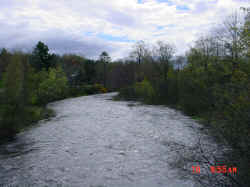 Recent surveys show that the Sheepscot has low canopy closure in comparison to other Maine Atlantic salmon DPS rivers (see Chart). This may reflect early successional riparian conditions, where bank vegetative cover is fairly high (SRWC, 2000), but canopy height insufficient to fully shade the stream. Larger order streams, such as the lower Sheepscot River (at left), are wide and open in their lower reaches and subject to warming because their width naturally exceeds local site potential tree height (100 feet).
Recent surveys show that the Sheepscot has low canopy closure in comparison to other Maine Atlantic salmon DPS rivers (see Chart). This may reflect early successional riparian conditions, where bank vegetative cover is fairly high (SRWC, 2000), but canopy height insufficient to fully shade the stream. Larger order streams, such as the lower Sheepscot River (at left), are wide and open in their lower reaches and subject to warming because their width naturally exceeds local site potential tree height (100 feet).
The Sheepscot River Watershed Council (2000) did an inventory of the West Branch Sheepscot River and found some reaches in a disturbed condition. Dairy farms, power lines, encroaching suburban parcels and ORV paths were among the sources of disturbance. They also noted that riparian buffers sometimes provided shade with one row of trees, but that this was insufficient for proper riparian function
Defining a Functional Riparian Zone for Atlantic Salmon Streams
The Draft Recovery Plan for Maine DPS Atlantic Salmon Rivers (NMFS/USFWS, 2004) provides the following information on the importance of riparian zones:
"Vegetated riparian buffers provide shade, regulate temperature and stream flow, protect water quality and act as a source of woody debris and organic matter (Kleinschmidt 1999). Vegetated riparian buffers provide a number of functions important for maintaining salmon habitat. Naturally vegetated riparian buffer zones are critical to maintain the health of adjacent aquatic systems. Establishing and maintaining riparian buffers is an critical means of protecting Atlantic salmon habitat. Significant disturbances that alter riparian habitat adjacent to salmon rivers can result in degradation of salmon habitat (Kleinschmidt 1999). Activities that have the potential to degrade instream habitat include timber harvesting, road construction, agriculture and development (Moring and Finlayson 1996)."
Stafford et al. (1999) found: "increases in stream temperature can be reduced or entirely prevented by leaving a protective tree cover along streams" with proper retention of buffer strips limiting maximum stream temperature increase to less than 2 degrees C (Binkley and Brown 1993). They cited Garman (1984) who showed that removal of 80% of the riparian vegetation on the East Branch of the Piscataquis River, a fourth-order Maine stream, caused a marked increase in both maximum temperature and diurnal fluctuations. Similar results from elsewhere in Maine (Pierce et al. 1993) and New England were also cited (Burton and Likens, 1973; Noel et al., 1986).
Other findings of Stafford et al. (1999) were:
-
In river systems with Atlantic salmon, protecting small streams is important because first-order streams constitute 20%–40% of the available habitat.
-
Increased temperature has been linked to changes in stream biota in the Northeast. Garman (1984) reported higher summer water temperatures and larger diurnal water temperature fluctuations after clearcutting along the East Branch of the Piscataquis River. Increases in water temperatures were believed to be responsible for the disappearance of brook trout.
-
When harvesting reduced shading by only 5%, no significant temperature changes occurred in a small tributary of the Aroostook River, Maine (Mullen and Moring 1988). Correspondingly, no significant differences in periphyton or brook trout populations were noted after cutting.
-
A buffer strip of trees as wide as one tree height on the south side of streams is most effective in preventing stream temperature increases (White and Krause 1993).
Hagan and Whitman (2000) showed that maintaining cool water temperatures with forest buffers was likely a result of keeping cool ambient air temperatures over streams. Gilliam (1994) also found that maintaining a riparian buffer was the most effective way to prevent sediment and nutrients from reaching a watercourse. In western streams, Bartholow (1989) found that air temperature over the stream is a more important driver of maximum water temperature than shade.
Kleinschmidt (1999) defined a 35 foot minimum width for no disturbance (Zone 1) next to Maine DPS Atlantic salmon streams and also set minimum stocking standards for a second riparian band (Zone 2) that would extend from a minimum of 70’ to a maximum of several hundred feet. They discourage activities that would cause compaction, remove duff, introduce chemicals or fertilizers or reduce stocking levels to such a degree as to loose "wind-firm" conditions to prevent blow down of riparian trees left after timber harvest. Haberstock (2000) states that this "is consistent with desired buffer functions such as shading, woody debris inputs, and water quality maintenance." He also notes:
"Buffer widths should not be relaxed for smaller streams. Small first order streams are actually more vulnerable to impacts from sedimentation, solar heating, base flow alterations (e.g., water withdrawals) and other potential effects of logging, agriculture, and other land uses, because they are less able to dilute or buffer such impacts."
The National Marine Fisheries Service and U.S. Environmental Protection Agency (2004) have signed an MOU with the State of Maine pursuant to Atlantic salmon recovery, which requires that the Maine legislature act to improve riparian protection through improved Forest Practice Rules. Irland (2000) suggests the need for reshaping forest management to make it more compatible with maintaining biodiversity and meeting other competing uses for Maine's forests.
Restoring Riparian Zones to Benefit Atlantic Salmon
The Atlantic Salmon Conservation Plan for Seven Maine Rivers (MASTF, 1997) called for protecting and restoring riparian zones. Grass roots groups, such as the Sheepscot River Watershed Council (SRWC), have formed to help improve watershed function and restore Atlantic salmon (SRWC, 2000). The SRWC (2000) survey and restoration of riparian areas is an example of efforts that are going on in other DPS rivers (Kleinschmidt, 2002; Arter, 2002). The SRWC works with the Sheepscot Valley Conservation Association and Soil and Water Conservation Districts on riparian restoration projects in the Sheepscot River basin.
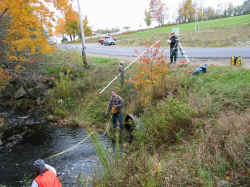
Sheepscot River Watershed Council volunteers survey a West Branch tributary with impaired riparian function. They rated riparian problems to enable restoration prioritization as High, Medium and Low (see examples).
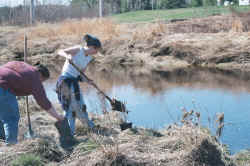 Volunteers for the Sheepscot Valley Conservation Association plant trees in a site along the West Branch Sheepscot River where shade is less than optimal for maintaining cool water temperatures.
Volunteers for the Sheepscot Valley Conservation Association plant trees in a site along the West Branch Sheepscot River where shade is less than optimal for maintaining cool water temperatures.
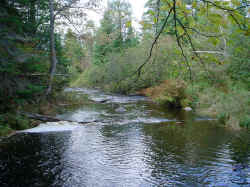 This reach of the West Branch Sheepscot River is in advanced recovery from past impacts. A canopy of both hardwoods and conifers provides a buffer that will moderate water temperature extremes and supply some large wood to the channel. The reforestation of the Sheepscot River riparian has been proceeding for several decades and riparian function is recovering as succession advances. Photo by Melissa Halsted.
This reach of the West Branch Sheepscot River is in advanced recovery from past impacts. A canopy of both hardwoods and conifers provides a buffer that will moderate water temperature extremes and supply some large wood to the channel. The reforestation of the Sheepscot River riparian has been proceeding for several decades and riparian function is recovering as succession advances. Photo by Melissa Halsted.
Laser (2005) made the following suggestions for how to set goals and objectives for riparian restoration in Gulf of Maine, despite the lack of baseline data:
"Future research ought to look at coastal Maine rivers as ecosystems. To describe a reference condition and understand what the riparian forest looked like pre-European settlement, research should focus on identifying the environmental change that has occurred using historical records, models, and paleoenvironmental data. A thorough assessment of the current state of the riparian forest and the interaction with the stream channel is essential. This assessment needs to be interdisciplinary in approach drawing primarily on the disciplines of forestry, geomorphology, and ecology. Models can be developed to better understand the temporal scale involved with restoration of function, as well as to better understand disturbance regimes in the watershed and how wood might move through the system. Experiments to identify how additional structure in the channel through additions of wood might affect habitat diversity are critical."
For more information on this topic, see also:
Hypothesis #3: Lack of aquatic habitat complexity has contributed to the decline of Atlantic salmon in the Sheepscot River watershed.
Or for riparian function as it relates to Pacific Salmon, see the following KRIS Background pages on the Internet.
Riparian Function and Protection of Pacific Salmon Streams http://www.krisweb.com/stream/riparian.htm
The Important of Large Wood in Pacific Salmon Streams http://www.krisweb.com/stream/bigwood.htm
References
Arter, B.S. 2002. Narraguagas Watershed Management Plan. Conducted in Cooperation with Project SHARE on behalf of the Narraguagas River Watershed Council, Cherryfield, ME. Funded from CWA Section 319h funds by the Maine Department of Environmental Protection. 86 p. Posted at www.salmonhabitat.org/nrwmp02.pdf
Bartholow, J.M. 1989 . Stream temperature investigations: field and analytic methods. Instream flow information paper no. 13. Biological Report 89(17). U.S. Fish and Wildlife Service, Fort Collins, Co. [900 kb]
Bilby, R.E. and J.W. Ward. 1989. Changes in characteristics and function of woody debris in increasing size of streams in western Washington. Transactions of the American Fisheries Society. 118: 368-378.
Binkley, D., and T.C. Brown. 1993. Management impacts on water quality of forests and rangelands. USDA For. Ser. Gen. Tech. Report RM-239.
Bryant, F.G. and J.V. Mahoney. 1950. West Branch of the Sheepscot River Stream Survey. Memo file cards containing information. Maine Atlantic Sea Run Salmon Commission, Bangor, ME. 86 p.
Burton, T.M., and G.E. Likens. 1973. The effect of strip-cutting on stream temperatures in the Hubbard Brook Experimental Forest, New Hampshire. BioScience 23:433–435.
Cunjak, R.A., Prowse, T.D., and D.L. Parrish. 1998. Atlantic salmon in winter: 'the season of parr discontent' Canadian Journal of Fisheries and Aquatic Sciences 55: 161-180.
Dahlström, N. and C. Nilsson. 2004. Influence of woody debris on channel structure in old growth and managed forest streams in Central Sweden. Environmental Management 33(3): 376-384.
Garman, G.C. 1984. Initial effects of deforestation on community structure and function of the East Branch Piscataquis River, Maine. Ph.D. Thesis. Department of Zoology, University of Maine.
Gilliam, J.W. 1994. Riparian wetlands and water quality. J. Environ. Quality 23(5): 896–900.
Grow, M.M. 1975. China, Maine: Bicentennial History. Weeks Mills ME: Marion T. Van Strien.
Hagan, J. and Andrew Whitman. 2000. Do Riparian Buffer Strips Maintain Interior-Forest Air Temperatures? In Wagner, R.G and J.M. Hagan (Eds). 2000. Proceedings of a Conference: Forestry and the Riparian Zone. University of Maine, Orono. Pages 61-62.
Haberstock, A. 2000. Method to Determine Effective Riparian Buffers for Atlantic Salmon Habitat Conservation. Kleinschmidt, Energy and Water Resource Consultants, Pittsfield, ME. In Wagner, R.G and J.M. Hagan (Eds). 2000. Proceedings of a Conference: Forestry and the Riparian Zone. University of Maine, Orono. Pages 55-56.
Irland, L.C., 1998, Maine’s Forest Area, 1600-1995-Review of Available Estimates. College of Natural Sciences, Forestry, and Agriculture, University of Maine, Maine Agricultural and Forest Experiment Station. Miscellaneous Publication 736. 12 p.
Irland, L. 2000. Maine Forests: A Century of Change, 1900-2000 …and elements of policy change for a new century. Maine Policy Review, Winter, 2000: 66-77.
Kleinschmidt Associates. 1999. Method to Determine Optimal Riparian Buffer Widths for Atlantic Salmon Habitat Protection. Report to the Maine State Planning Office, Augusta, Maine, by Kleinschmidt Associates, Consulting Engineers and Scientists, Pittsfield, Maine. 100+ pp.
Kleinschmidt Associates. 2002. Dennys River Corridor Land Management Plan. Performed under contract to the Maine Atlantic Salmon Commission. Kleinschmidt Associates, Consulting Engineers and Scientists, Pittsfield, Maine. Posted at: http://www.state.me.us/asa/LMP%20Dennys/
Laser, M. 2005. Process-Based Restoration of Riparian Function: A Theoretical Justification. Partial fulfillment of candidacy requirement at Antioch New England Graduate School. 54 p.
Lorimer, C. G. 1977. The pre-settlement forest and natural disturbance cycle of northeastern Maine. Ecology 58:139148.
Maine Atlantic Salmon Task Force. 1997. Atlantic Salmon Conservation Plan for Seven Maine Rivers. 309 pp. [1.6Mb]
Moring, J.R. And K. Finlayson. 1996. Relationship between land use activities and Atlantic salmon (Salmo salar) habitat: a literature review. Report to the National Council of the Paper Industry for Air and Stream Improvement, Inc. January 1996.
Mullen, D.M., and J.R. Moring. 1988. Partial deforestation and short-term autochthonors energy input to a small New England stream. Water Resources Bulletin 24:1273– 1279.
National Marine Fisheries Service (NMFS) and U.S. Fish and Wildlife Service (USFWS). 2004. Draft Recovery Plan for the Gulf of Maine Distinct Population Segment of Atlantic Salmon (Salmo salar). National Oceanic and Atmospheric Administration, NMFS, and Northeastern Region USFWS. Silver Spring and Hadley, MA. 239 pp. [950 kb]
National Marine Fisheries Service and U.S. Environmental Protection Agency. 2003. Maine Coastal Nonpoint Source Program NOAA/EPA Decisions on Conditions of Approval. US DOC, National Oceanic and Atmospheric Administration and US EPA. Washington D.C. 20 p.
Noel, D.S., C.W. Martin, and C.A. Federer. 1986. Effects of forest clearcutting in New England on stream macroinvertebrates and periphyton. Environmental Management. 10:661–670.
Pierce, RS, J.W. Hornbeck, C.W. Martin, L.M. Tritton, C.T. Smith, C.A. Federer, and H.W. Yawney. 1993. Whole-tree clearcutting in New England: manager’s guide to impacts on soils, streams, and regeneration. USDA Forest Service, General Technical Report NE-172.
Plantinga, A. J., T. Mauldin, and R. J. Alig. 1999. Land use in Maine: determinants of past trends and projections of future changes. U.S. Department of Agriculture, Forest Service. Pacific Northwest Research Station. Res. Pap. PNWRP-511. Portland, OR . 28 pp. [262 Kb]
Sader, S., S. Murphy, and M. Bertrand. 2004. The State of Maine's Forests. Dept. of Forest Management, University of Maine, Orono. Funded through Maine Ag. And Forest Experiment Station and NASA Maine Forest Project (NAG 13-98008). Compact Disc and Internet site: http://www.ume.maine.edu/~MIAL/maine_cd/firstpage.htm
Sedell, J. R., P. A. Bisson, E J. Swanson, and S. V. Gregory. 1988. What we know about large trees that fall into streams and rivers. Pages 47-81 in: From the Forest to the Sea: A Story of Fallen Trees, (eds.) C. Maser, R. F. Tarrant, J. M. Trappe, and J. E Franklin. U.S. Forest Service General Technical Report PNW-GTR-229. See the U.S. Forest Service website for report at http://www.fs.fed.us/pnw/pubs/gtr229
Seymour, R. S., and M. L. Hunter, Jr. 1992. New forestry in eastern sprucefir forests: principles and applications to Maine. Maine Agricultural Experiment Station Miscellaneous Publication 716. 36 pp.
Sheepscot River Watershed Council. 2000. Sheepscot River West Branch Riparian Inventory. Performed by the Sheepscot River Watershed Council with funding from the Maine State Office of Planning, Augusta, ME. 52 p.
Spence, B.C., G.A. Lomnicky, R.M. Hughes and R. P. Novitzki. 1996. An Ecosystem Approach to Salmonid Conservation. Funded jointly by the U.S. EPA, U.S. Fish and Wildlife Service and National Marine Fisheries Service. TR-4501-96-6057. Man Tech Environmental Research Services Corp., Corvallis, OR. http://www.nwr.noaa.gov/1habcon/habweb/habguide/ManTech/front.htm
Stafford, C., M. Leathers and R. Briggs. 1999. Forestry Related Nonpoint Source Pollution in Maine: A Literature Review. Cooperative Forestry Research Unit, University of Maine, Orono, ME. Miscellaneous Paper # 399. 20 p.
U.S. Geologic Survey. 2004. Status and Trends of the Nation's Biological Resources. USGS, National Biological Survey. Internet website with numerous authors at http://biology.usgs.gov/s+t/SNT/index.htm.
Wagner, R.G and J.M. Hagan (Eds). 2000. Proceedings of a Conference: Forestry and the Riparian Zone. University of Maine, Orono. 88 p.
White, J.B., and H.H. Krause. 1993. The impact of forest management on water quality and the establishment and management of protective buffer zones. Department of Forest Resources, University of New Brunswick.
